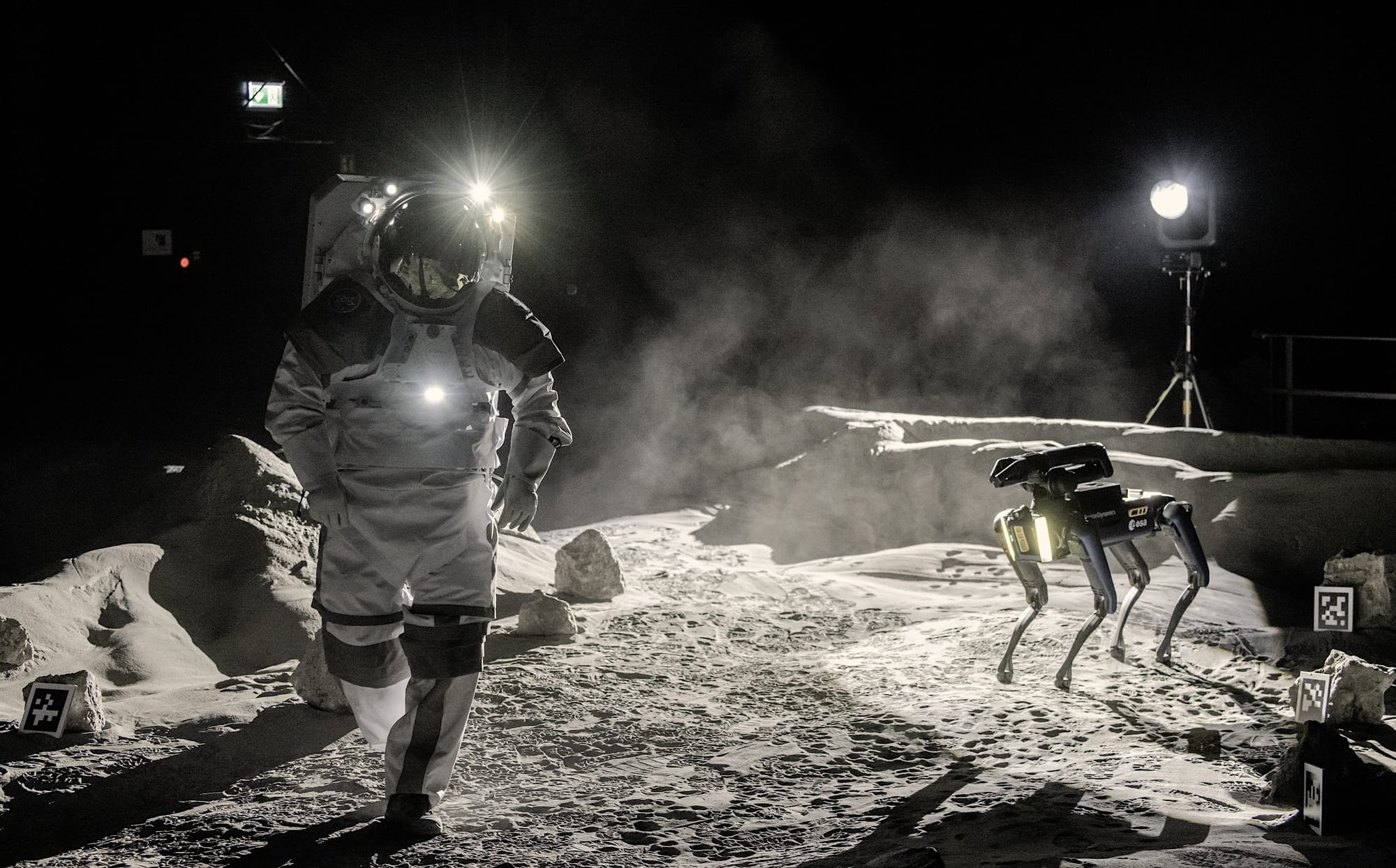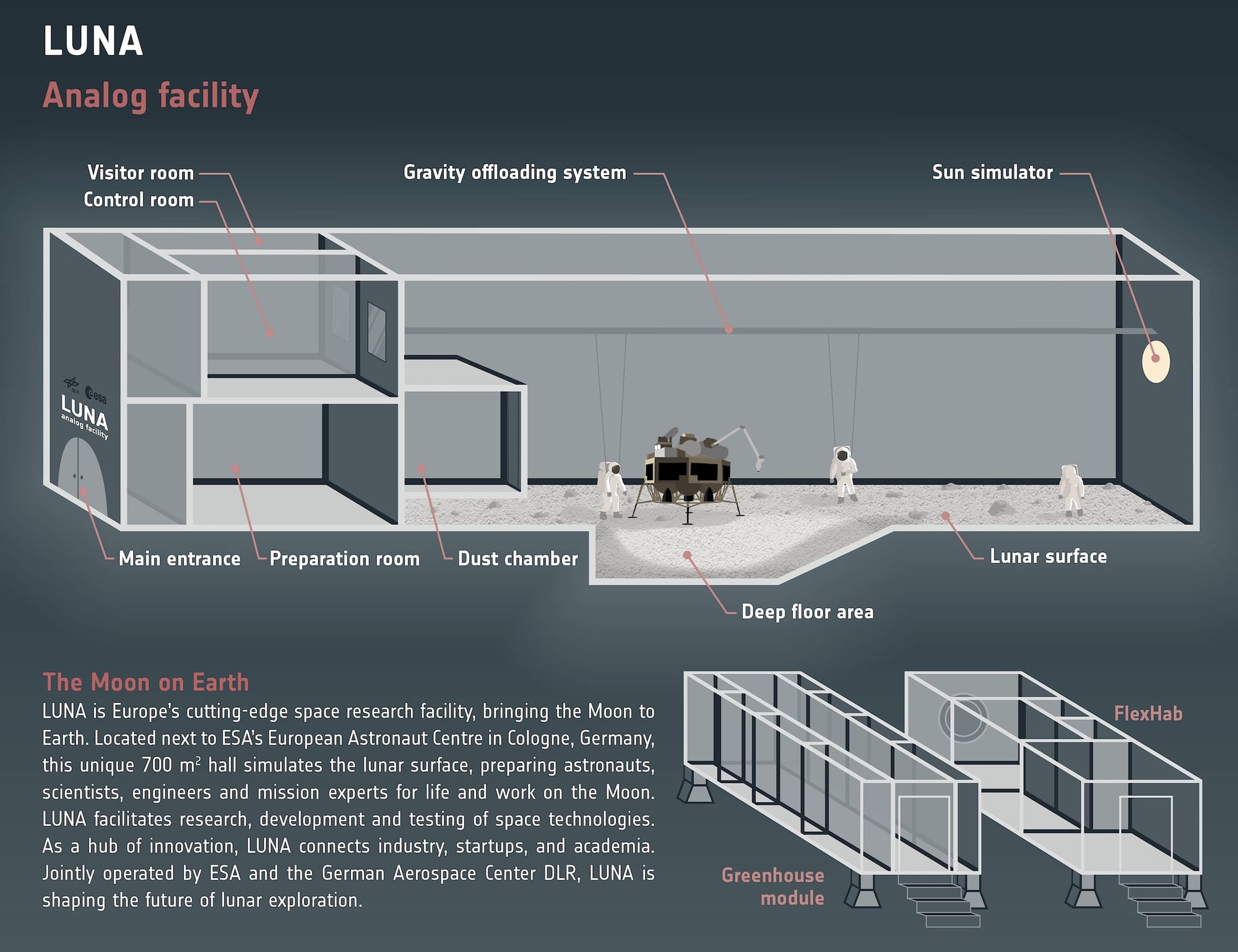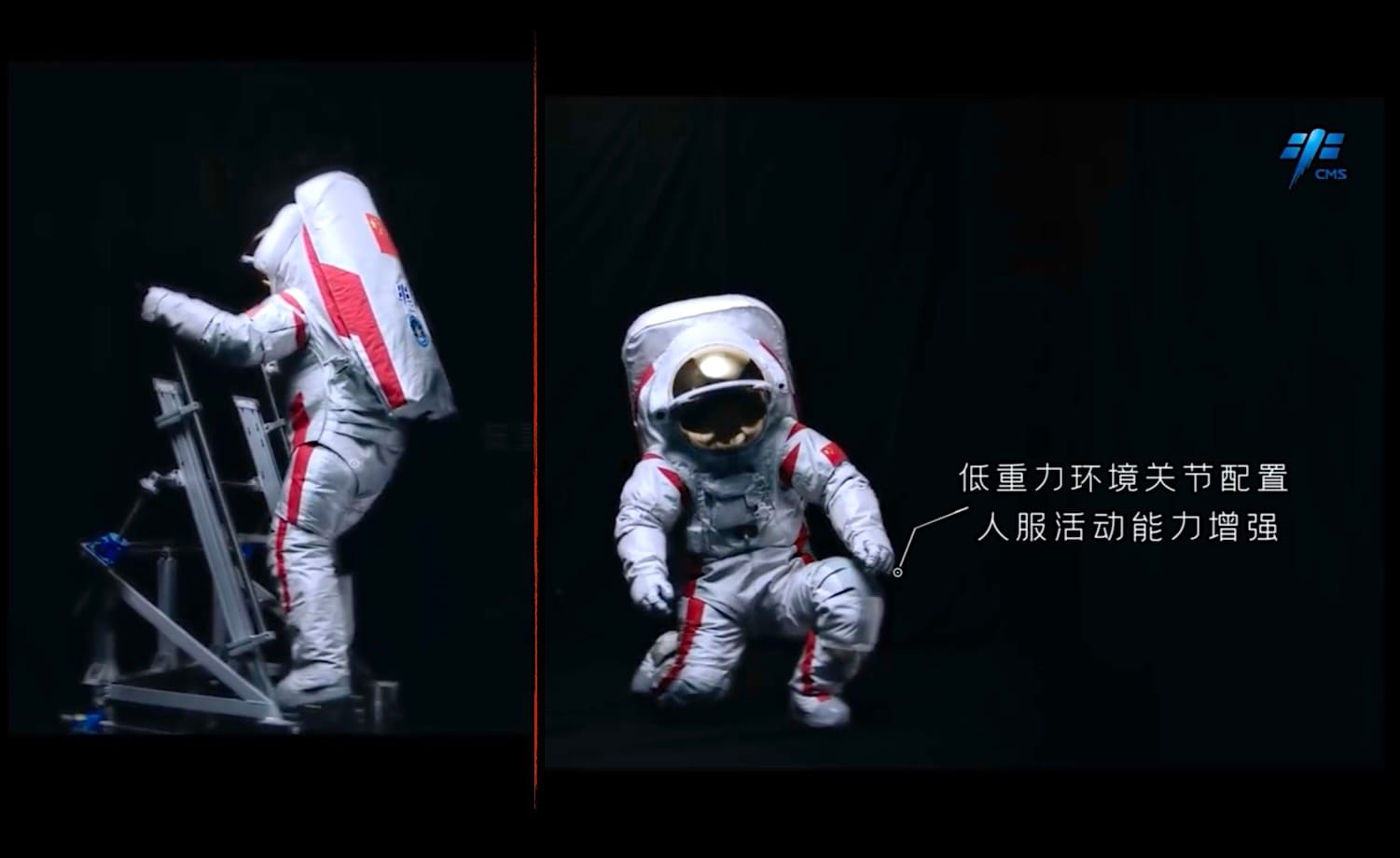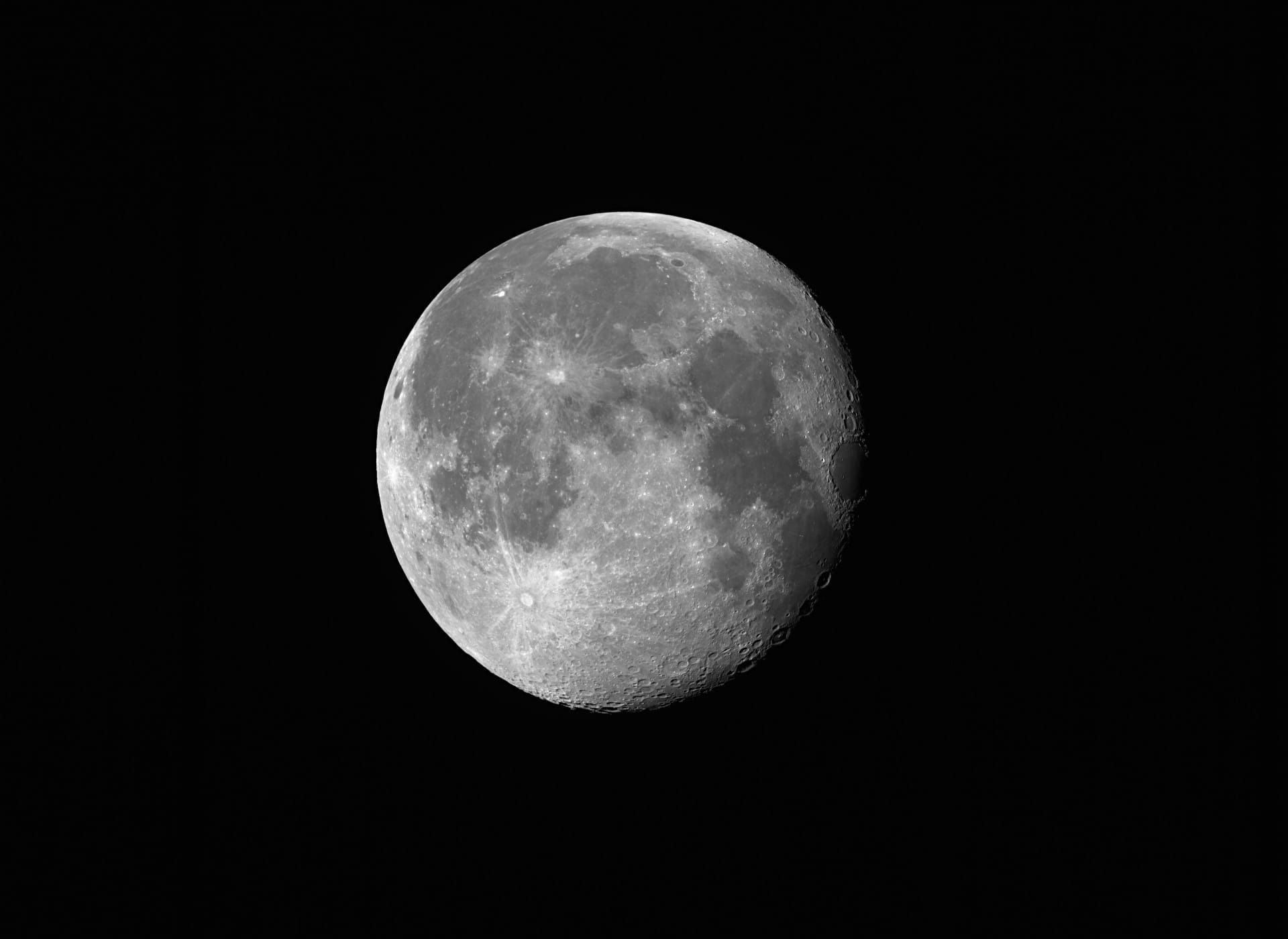Moon Monday #195: Little LUNA on Earth, a Sino spacesuit, and communicating navcom
You know how I remarked in the previous Moon Monday about having two feature stories instead of one to adequately contextualize big new developments? Well, this week’s Moon Monday has three! For Europe, China, and the US. 🙈
Europe’s new test facility brings more of those lunar vibes on Earth

On September 25, ESA and DLR inaugurated a 700-square-meter LUNA test facility near Cologne in Germany, which when fully complete will simulate multiples aspects of our Moon to conduct robotic and crewed exploration hardware tests, touting:
- a lunar-like volcanic regolith surface
- simulated lunar polar sunlight cycles
- sampling and drilling areas (up to 3 meters)
- an adjustable ramp for testing rover mobility on lunar slopes
- a simulated entrance to a lava tube
- spacesuits and a fascinating vertical suspension system to allow astronauts to perform simulate Moonwalks under lunar-equivalent gravity
- a seismic station
- and a connected habitat training area
ESA and DLR will also add more testing niceties over time so the above list is not even comprehensive! The LUNA facility is located next to ESA’s European Astronaut Centre. ESA says space agencies, academia and researchers, and space companies from all over the world can make use of LUNA facilities for testing their lunar hardware, prototypes, and operational scenarios.

LUNA is the crest of a coordinated effort across Europe by ESA and several national space agencies to invest in comprehensive planetary testing facilities.
- Last year in September, DLR inaugurated a new 1500-square-meter Moon-Mars facility in Oberpfaffenhofen to test mobile robotic explorers on basaltic surfaces and landforms similar to those on the Moon and the Red Planet.
- The Luxembourg-ESA co-run European Space Resources Innovation Centre (ESRIC) aims to establish a terrestrial pilot plant to accelerate as well as de-risk technologies and concepts related to extracting and utilizing lunar oxygen and other resources before their use in actual Moon missions.
- DLR has been testing a robotic motion simulator configured to mimic a lander’s motions as it would be during descent and touchdown on the rocky terrain at the Moon’s south pole. With this, ESA aims to establish preliminary requirements for an eventual crewed lunar lander—although no such funded plan currently exists. The simulator allows testing multiple landing scenarios, including manually avoiding hazardous regions and overriding autonomous landing in favor of manual controls after experiencing technical faults.
- ESA runs the Pangaea campaign, which trains international partner astronauts in lunar geology, a highly valuable skill when exploring the Moon and collecting samples
- ESA and DLR have been pooling researchers from across the continent for the “Movement in low gravity environments” (MoLo) program to study how human bodies would react and adapt long-term in lunar gravity, particularly in the context of stays in lunar habitats. Based on their current research using bungee rope-like setups and parabolic flights both simulating some lunar conditions, it seems that having astronauts do controlled hopping coupled with the expected extravehicular activities (EVAs) as well as daily tasks could be effective in helping mitigate or even prevent physiological deconditioning.
A Sino suit for Luna

On September 28, the China Manned Space Agency (CMSA) unveiled their lunar spacesuit prototype design, thus revealing the final major element that will be employed in China’s march towards realizing a crewed Moon landing by 2030. Just like was the case of China’s crewed lunar lander and spacecraft, China is asking its citizens to help name the suit by submitting ideas by October 31.
The on-stage demos showed a suited person climbing a ladder akin to what an astronaut would do after China’s first crewed Moon landing. CMSA says the lightweight lunar suit is designed to ease walking on multiple lunar terrains, and that it allows better squatting and bending than suits used in Earth orbit since those actions are useful for lunar sampling and deploying & operating surface instruments. Naturally, the suit is (and has to be) made to withstand the extreme vacuum, radiation, dust, and thermal environments of the Moon.
Supposedly, the suit is fully indigenous, unlike the Russian-derived-and-inspired suits China currently uses on its Earthbound human spaceflight missions. CMSA’s deputy chief designer Zhang Hailian stated last year that the suits are designed such that astronauts can explore the lunar surface for at least eight hours at a time. As Andrew Jones reported, the suit’s anti-glare visors, helmet cameras, and a control console (and likely headlights) will aid astronauts during such excursions.
On the other side of the world, Axiom Space is busy developing and purportedly prioritizing the AxEMU suit that Artemis astronauts will wear for the program’s first US Moon landing. The suits remain a pacing item for the mission alongside the SpaceX Lunar Starship lander.
Back to China’s crewed Moon landing plan, in May 2023 CMSA solicited industry proposals for a mission rover, which the crew can drive up to 10 kilometers from the landed site. That’s more than the range of the Lunar Roving Vehicle (LRV) driven by Apollo astronauts but does fall short of the 20-kilometer peak of the upcoming Artemis Lunar Terrain Vehicle. In any case, 10 kilometers is in itself a decent range for expansive crewed Moon missions.
Many thanks to Arun Raghavan and Frank Genin for sponsoring this week’s Moon Monday! If you too appreciate my efforts to bring you this curated community resource, kindly join them and support my independent writing.
Intuitive Machines to also launch lunar comm relays
not yet for $4.82 billion..

NASA is awarding $150 million to Intuitive Machines for launching the first few satellites which will provide navigation and communications (navcom) services to hardware at the Moon part of crewed Artemis and robotic CLPS programs. The first such satellite will launch in late 2025 onboard the company’s third Moon landing mission. Two more will launch on Intuitive’s fourth lunar flight in 2027. With these and more such high-bandwidth communications satellites sent via CLPS, NASA hopes to reduce burden on the agency’s overworked Deep Space Network.
If Intuitive Machines manages multiple successful demonstrations with these initially contracted satellites, NASA’s awards to the company could potentially extend up to $4.82 billion for expanded services. But as the newsletter “The Space Investor” pointed out, most investors wrongly assumed $4.82 billion to be the currently contracted value instead of $150 million—which made Intuitive’s stocks soar. Part of the issue is the company’s press release did not mention the ~$150 million figure. I wonder why. But many western media publications covering the development didn’t dig up and specify the $150 million part either, including the very positive coverage from space journalism veteran Ars Technica, which in the same article continued to perpetuate Intuitive’s first Moon landing attempt as being more successful than it really was. Quote below, emphasis mine:
Despite some technical troubles, including the failure of its altimeter, the company's first lander managed a soft touchdown on the Moon on its side. Even with this unintended orientation, the Intuitive Machines-1 mission still managed to complete the vast majority of its science objectives.
Soft touchdown? It was not. Unless of course breaking a lander leg is a gentle landing in the New Moon Dictionary.
Completing the vast majority of its science objectives? Sure, if most payloads collecting limited data and one collecting none constitutes a vast majority.
Anyway, on the other side of the world, as part of a broader strategy for China’s upcoming full-fledged navcom constellation, the country has already deployed two communications relay orbiters: Queqiao 1 and Queqiao 2, which served the Chang’e 4 and Chang’e 6 missions respectively on the Moon’s farside. Queqiao 2 will also relay communications for China’s upcoming Chang’e 7 and Chang’e 8 lunar landers, which CNSA is targeting to launch in 2026 and 2028 respectively.
ESA also aims to have a navcom lunar constellation with its Moonlight initiative. The launch of UK’s Lunar Pathfinder orbiter in 2026 will constitute ESA’s first Moonlight element. ESA will be Moonlight’s anchor customer but expects European companies to actively commercially provide services to missions globally. For more on the US side, Lockheed Martin’s subsidiary Crescent Space was targeting a 2025 launch for its first two navcom lunar orbiters but there’s been no update on its progress. More potential competitors in the lunar navcom space include ArkEdge Space, Aquarian Space, and Plus Ultra but only China has launched hardware yet.
More mission updates
- Video: The next Moon landing missions by Intuitive Machines for NASA CLPS (based on Moon Monday!)
- “A piece of the Moon” is an excellent behind-the-scenes video showing key moments in operating the Chang’e 6 spacecraft, which successfully brought lunar samples from the Moon’s farside to Earth past June. Other than showing several people on the mission, the video features the terrestrial lander and local surface site replica which CNSA created to test and verify commands before sending them to the actual Chang’e 6 lander so as to avoid making mistakes during critical operations.
- ispace US has built a new control center for mission operations at its headquarters in Denver, Colorado. This development is in the run up to the first Draper-led Moon mission part of NASA’s CLPS program targeting a 2026 launch, wherein ispace’s US subsidiary is providing the lander. ispace US is also providing ground communications and relay satellite services for the mission to enable communications with the lander and its instruments on the Moon’s farside. Draper’s CLPS mission has been a driver of capital raises for ispace but the silver lining for science is that it hasn’t cost significant additional money to NASA unlike the case of several other CLPS missions including the first ones that flew this year from Astrobotic and Intuitive Machines.
More Moon
- Jeff Foust reports that Lockheed Martin has left the “Lunar Dawn” rover team led by Lunar Outpost competing for the development of a versatile Lunar Terrain Vehicle for Artemis. Lockheed’s departure has meant that Lunar Outpost had to significantly change their rover design to remove Lockheed’s intellectual property contributions. Separately, and not replacing Lockheed’s role, Leidos has joined the rover team to support work on astronaut safety and operations based on their experience serving NASA at the International Space Station. Relatedly, NASA has contracted Leidos to support cargo processing and management work for Artemis orbital and surface missions.
- Random lunar fact: Earth observation satellites periodically image the Moon to detect, calibrate, and correct deviations in the performance of their imagers. The latter happens naturally due to aging hardware, degradation of imager material or coating, radiation exposure, and other such factors. It’s our Moon’s stable and known light intensity that allows it to act as a celestial reference for satellites based on which they can continue accurate observations. Some fresh examples of satellites imaging Luna for calibration are ESA’s Copernicus Sentinel-2C and Azista Space’s AFR spacecraft.

